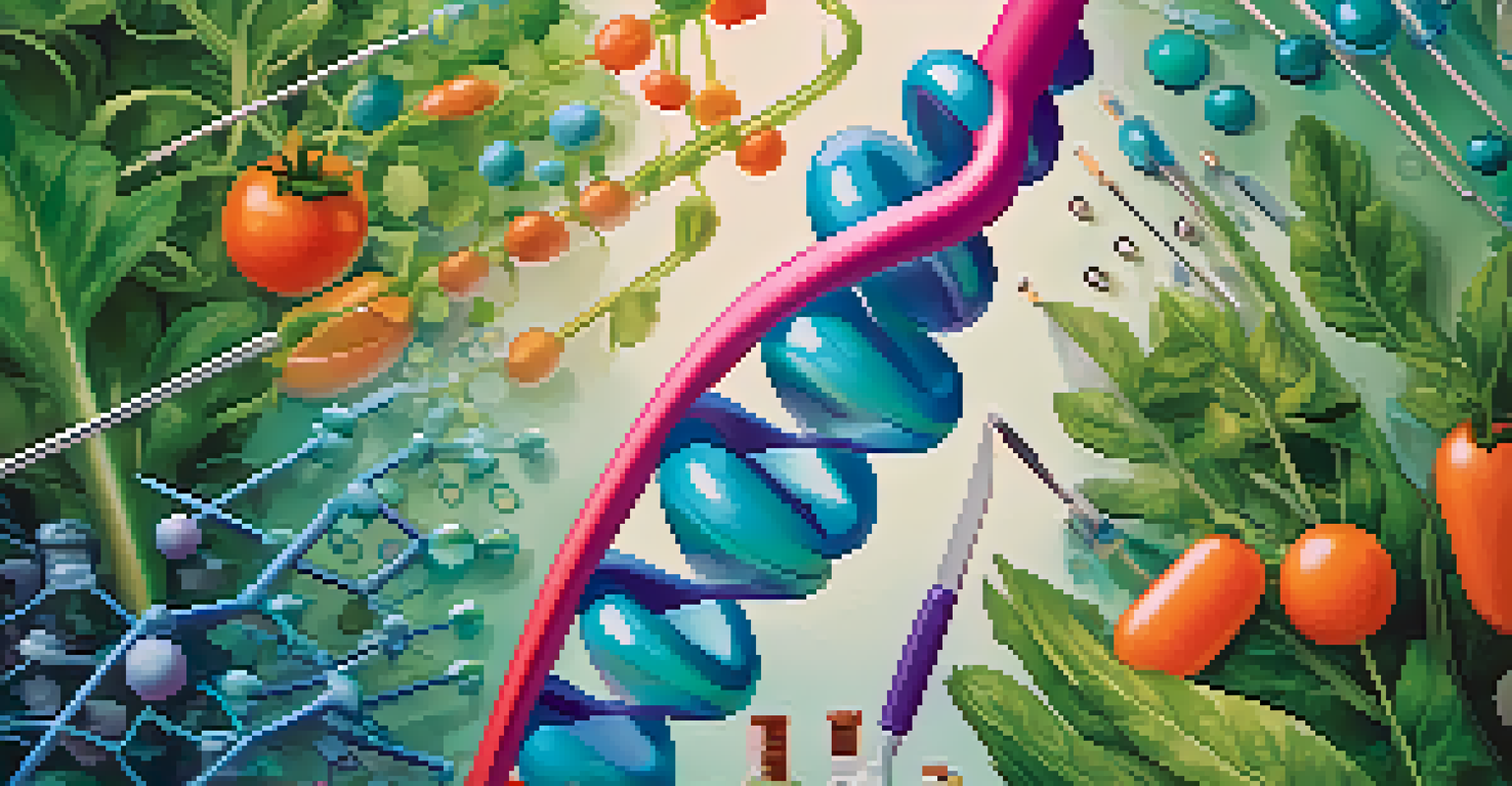CRISPR Technology: Revolutionizing Plant Genetic Modification

Understanding CRISPR: A Game-Changing Tool in Genetics
CRISPR, which stands for Clustered Regularly Interspaced Short Palindromic Repeats, is a revolutionary technology that allows scientists to edit genes with incredible precision. By harnessing this natural process, researchers can alter the DNA of living organisms, including plants, to enhance desirable traits. Imagine it as a pair of molecular scissors that can cut and modify genetic material, making it easier to develop new plant varieties.
CRISPR is a powerful tool for genetic engineering that can make precise changes in the DNA of living organisms, which could lead to revolutionary advances in agriculture.
What sets CRISPR apart from traditional genetic modification techniques is its simplicity and efficiency. Unlike older methods that often involved introducing foreign DNA, CRISPR can make subtle changes to existing genes. This means that scientists can enhance crops' resistance to pests or improve their nutritional content without the risk of introducing unwanted traits.
The potential applications of CRISPR in agriculture are vast, making it a hot topic among researchers, farmers, and consumers alike. From creating drought-resistant wheat to developing disease-resistant tomatoes, CRISPR technology is paving the way for a new era in plant genetics, promising to meet the challenges of feeding a growing global population.
The Science Behind CRISPR: How It Works
At its core, CRISPR technology relies on a naturally occurring defense mechanism found in bacteria. When bacteria are attacked by viruses, they store segments of the viral DNA in their own genome. Later, they use this information to recognize and cut the viral DNA during subsequent attacks, thus protecting themselves. Scientists have adapted this system for gene editing in other organisms, including plants.

The key components of CRISPR gene editing are the guide RNA and the Cas9 protein. The guide RNA is designed to match a specific DNA sequence in the plant genome, while the Cas9 protein acts as the scissors that cut the DNA at the targeted location. Once the DNA is cut, the plant's natural repair mechanisms kick in, allowing scientists to introduce changes with great accuracy.
CRISPR Transforms Genetic Editing
CRISPR technology offers unprecedented precision in gene editing, allowing scientists to enhance plant traits without introducing foreign DNA.
This process can lead to various outcomes, such as knocking out undesirable genes or inserting new ones. The ability to make these precise edits means that scientists can address specific traits without the unintended consequences often associated with traditional breeding methods. This level of control is what makes CRISPR such a powerful tool for modifying plant genetics.
Benefits of CRISPR in Plant Genetic Modification
The benefits of using CRISPR in plant genetic modification are numerous and significant. One of the most notable advantages is the ability to enhance crop yields, which is essential for feeding an increasingly hungry world. By making plants more resilient to environmental stresses, such as drought and disease, farmers can produce more food with less input.
The future of agriculture depends on our ability to innovate and adapt to challenges, and CRISPR technology is at the forefront of that change.
In addition to improving yield, CRISPR technology can also enhance the nutritional value of crops. For example, researchers are working on developing rice varieties enriched with vitamins and minerals, which could help combat malnutrition in vulnerable populations. This not only benefits consumers but also contributes to overall food security.
Moreover, CRISPR allows for a more sustainable approach to agriculture. By reducing the need for chemical pesticides and fertilizers, CRISPR-modified plants can lessen the environmental impact of farming. This aligns with the growing consumer demand for eco-friendly and sustainable food sources, making CRISPR a critical player in the future of agriculture.
Addressing Concerns: Safety and Ethics of CRISPR
As with any revolutionary technology, CRISPR has raised safety and ethical concerns that cannot be overlooked. Critics argue that gene editing could lead to unintended consequences, such as the creation of superweeds or the disruption of local ecosystems. It's essential for researchers to thoroughly assess these risks before widespread implementation in agriculture.
Another significant concern revolves around the ethical implications of gene editing. Questions arise about who gets to decide which traits are desirable and how these decisions might affect biodiversity. Moreover, there are debates about whether genetically edited crops should be labeled differently from conventionally bred varieties, allowing consumers to make informed choices.
Boosting Food Security with CRISPR
By developing crops that are more resilient to environmental stresses, CRISPR has the potential to significantly increase agricultural yields and nutritional value.
To address these concerns, regulatory bodies must establish clear guidelines for the use of CRISPR in agriculture. Transparency in research and open dialogues with the public can help build trust in this technology. By prioritizing safety and ethical considerations, we can harness CRISPR's potential while ensuring responsible usage in plant genetic modification.
Real-World Applications: CRISPR in Action
CRISPR technology is not just theoretical; it has already been put to practical use in various agricultural applications. One notable example is the development of soybeans that are resistant to pests, which allows farmers to reduce pesticide use and increase yields. This successful application showcases CRISPR's potential to enhance crop productivity while promoting environmental sustainability.
Another exciting project involves the creation of a new variety of banana that is resistant to Fusarium wilt, a devastating disease that threatens banana crops worldwide. By using CRISPR, researchers can help secure the future of this staple food, ensuring that it remains available for generations to come. Such initiatives highlight how CRISPR can contribute to food security in vulnerable regions.
These real-world examples illustrate the tangible benefits of CRISPR technology in agriculture. As more success stories emerge, we can expect to see further investment and research into its applications, driving innovation in plant genetic modification and transforming the agricultural landscape.
The Future of Agriculture: CRISPR's Role
Looking ahead, the role of CRISPR in agriculture is poised to expand significantly. With the pressures of climate change, population growth, and diminishing natural resources, innovative technologies like CRISPR will be crucial in developing resilient crops that can thrive in challenging conditions. This adaptability will be essential for maintaining food security in the face of global challenges.
Furthermore, as scientists continue to refine and improve CRISPR techniques, we can expect even greater precision in plant genetic modification. This could lead to the creation of crops tailored specifically to local environments and consumer preferences. Imagine a world where farmers can grow crops that are perfectly suited to their specific climate and soil conditions, maximizing both yield and sustainability.
Ethical Considerations in CRISPR Use
While CRISPR holds great promise for agriculture, it raises important ethical and safety concerns that must be carefully addressed through transparent research and regulation.
In summary, CRISPR technology holds immense promise for the future of agriculture. By enabling precise and efficient modifications to plant genomes, it paves the way for a new era of sustainable farming practices, ultimately benefiting both producers and consumers. The continued exploration of CRISPR will be vital in addressing the pressing challenges facing our food systems.
Conclusion: Embracing the CRISPR Revolution in Agriculture
In conclusion, CRISPR technology stands at the forefront of a revolution in plant genetic modification, offering unparalleled opportunities for innovation in agriculture. By providing a powerful tool for precise gene editing, it enables researchers to develop crops that can better withstand the challenges posed by climate change, pests, and diseases. This not only benefits farmers but also consumers seeking healthier and more sustainable food options.
While there are valid concerns regarding the safety and ethics of gene editing, these should not overshadow the incredible potential that CRISPR offers. With responsible research, transparent practices, and a commitment to addressing ethical dilemmas, we can create a framework that harnesses the benefits of CRISPR while minimizing risks.

As we move forward, embracing the CRISPR revolution in agriculture will be essential for ensuring a food-secure future. By investing in this technology and fostering an open dialogue about its implications, we can unlock the full potential of CRISPR and transform the way we grow and interact with our food.